Boston Living with Water organizers announce nine finalists in international climate change competition
Feb 26, 2015
Teams will compete for $20,000 grand prize to be awarded in June
 Architects, urban planners, designers, climate change advocates, and policymakers got a unique glimpse into what a more resilient and sustainable Boston might look like in the face of sea level rise last night. One proposal envisions a sort of Boston Common in the Fort Point Channel that visitors would explore via canoes, kayaks, and paddle boards. Another imagines elevating a section of Morrissey Boulevard and creating a living laboratory with marsh, aquatic grasses, and shellfish beds underneath. Others contemplate the potential for “water days” in the not-so-distant future where the city is challenged by frequent flooding.
Architects, urban planners, designers, climate change advocates, and policymakers got a unique glimpse into what a more resilient and sustainable Boston might look like in the face of sea level rise last night. One proposal envisions a sort of Boston Common in the Fort Point Channel that visitors would explore via canoes, kayaks, and paddle boards. Another imagines elevating a section of Morrissey Boulevard and creating a living laboratory with marsh, aquatic grasses, and shellfish beds underneath. Others contemplate the potential for “water days” in the not-so-distant future where the city is challenged by frequent flooding.
These proposals were among the dozens of submissions entered in the ongoing Boston Living with Water competition, an initiative launched by the City of Boston, The Boston Harbor Association, the Boston Redevelopment Authority (BRA), and the Boston Society of Architects last October to encourage planning for end-of-the-century climate conditions and rising sea levels. 50 teams composed of almost 350 individuals from eight different countries submitted concepts. While the entries showcase an impressive range of potential climate change solutions, they have one thing in common. They all embrace sea level rise as an opportunity to enhance, rather than detract from, Boston’s built environment.
“We issued an ambitious challenge through the Boston Living with Water competition, and I’m pleased that we received equally ambitious responses,” said Mayor Martin J. Walsh. “It’s difficult to imagine what the world will look like in the year 2100, but we know for certain that now is the time to prepare for sea level rise. The proposals that came in from around the world demonstrate that a more resilient, sustainable, and beautiful future is within our reach if we work together.”
BSA Space, Boston’s leading center for architecture and design, hosted a special reception to announce the finalists in the competition. Guests enjoyed a lively panel discussion with the competition’s jury, moderated by WGBH’s Rupa Shenoy. Members of the jury included BRA planning director Kairos Shen, Matt Noblett, principal at Behnisch Architekten, landscape architect Jason Hellundrung of Sasaki Associates, land use attorney Matthew Kiefer of Goulston & Storrs, Marggie Lackner, deputy director of design for the MBTA, and Judith Nitsch, founder of Nitsch Engineering. Austin Blackmon, the City of Boston’s new Chief of Environment, Energy, and Open Space also spoke at the event.
The competition focuses on three unique sites in Boston that are vulnerable to sea level rise and present challenges at different scales – a building, an entire neighborhood, and a significant piece of city infrastructure. The sites were the Prince Building in the North End, Morrissey Boulevard in Dorchester, and the 100-acre neighborhood of Fort Point. Water levels in Boston Harbor are expected to increase five feet by the end of the century, putting these locations in particular jeopardy.
The jury evaluated each submission’s ability to solve multiple problems, including minimizing damage from chronic and episodic coastal flooding. Successful proposals mitigated adverse building impacts on the environment, enhanced climate resiliency, and demonstrated feasibility of implementation and replication.
An online gallery of all the submissions is available at www.bostonlivingwithwater.org/submission-gallery.
The jury whittled dozens of submissions down to three finalists per site category. These teams will move on to compete for a $20,000 grand prize, funded by the Massachusetts Office of Coastal Zone Management and the Barr Foundation.
The finalists selected in the building category are:
-
“The Prince Building Piers” led by Stephanie Goldberg AIA and Mark Reed AIA – Rather than trying to prevent seawater from entering the city, this proposal welcomes the water and surrenders the outer streetscapes to a new urban seashore that is a focus of recreation, ecological reclamation, and new cultural experiences.
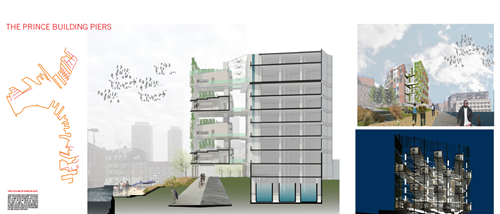
-
“Water FUN(d)” led by ARC/Architectural Resources Cambridge – Dubbed the Future Underwater Neighborhood district, or FUN(d), this proposal establishes a goal of creating a new urban area that skillfully interacts with an influx of water on an on-going basis. The team suggests that this plan could be accomplished, at least in part, by drawing on revenue from Boston’s tourism economy.
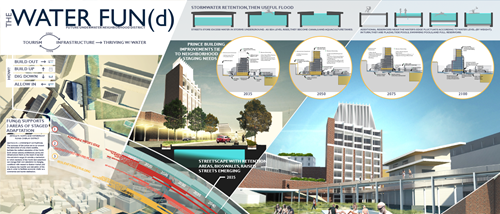
-
“No Building is an Island” led by Harvard Graduate School of Design – One of the most creative aspects of this proposal is the Resilience Report Card, a simple, user-friendly method that would indicates a building’s vulnerability and allow the city to map risk and target investments.
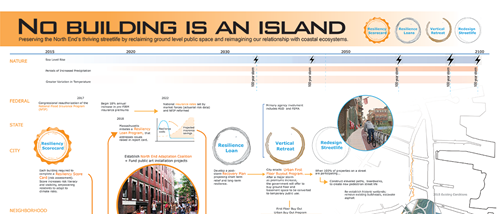
The finalists selected in the neighborhood category are:
-
“Bountiful Delta” led by University of Washington – Guided by the notion that resilience alone is not good enough, this proposal envisions waterfront neighborhoods that “are not just persistent but prosperous.” The strategy calls for modular infrastructure, adaptable land (think of a community garden that could be transformed for fish farming), a lively and water-resilient pedestrian streetscape, and community spaces, restaurants, and retail establishments to provide a genuine neighborhood feel.
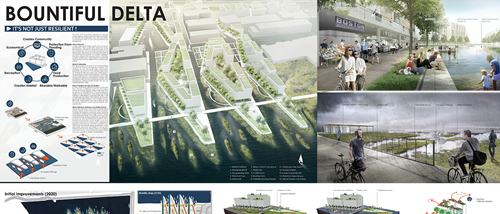
-
“Resilient Linkages” led by NBBJ – This proposal attempts to balance the immediate pressure for development in Fort Point with the long-term understanding that the area will be prone to regular flooding in the future. The plan would establish a new, elevated street grid and require developers to integrate supportive infrastructure for sea level rise into their projects, which could then be linked to form fully-functional, neighborhood-scale infrastructure.
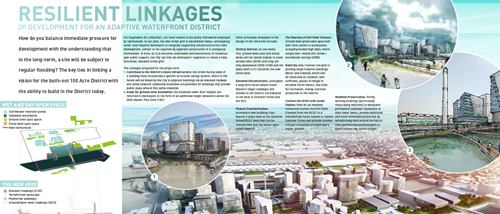
-
“Model Urban Waterfront District” led by Architerra Inc. – This proposal would raise the entire base and infrastructure of the 100-acre neighborhood by approximately twelve feet, matching the raised elevation of historic Summer Street and creating a resilient development area to serve as a model urban waterfront district for the 21st and 22nd centuries.
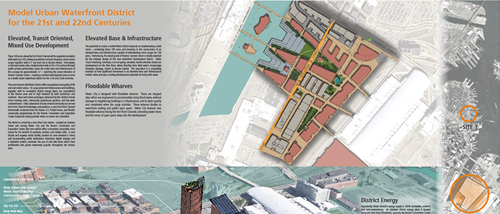
The finalists selected in the infrastructure category are:
-
“The Hydrokinetic Canal” led by Paul Lukez Architecture - This proposal for transforming Morrissey Boulevard and Harbor Point over the next 100 years draws inspiration from the topographic and land-use patterns of 17th century Boston. A new system of waterways would be created to increase Columbia Point’s resilience to climate change, generate sustainable energy, and provide an expanded, improved public realm. A new Hydrokinetic Canal is this urban plan’s centerpiece.
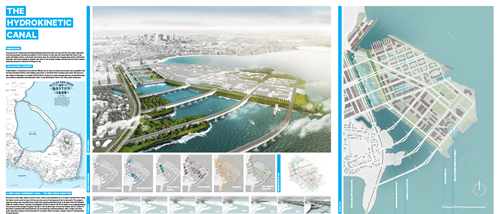
-
“The Omega Chain” led by Howard & Cavaluzzi Architects Int. LLC, Beijing Office – The Omega Chain would be a resilient network system around the Columbia Point peninsula that connects disparate areas with holistic mechanisms that transcend simple solutions and elevate quality of life for residents. It contemplates gradually converting the existing Morrissey Boulevard into a landscaped park and constructing a new elevated and curved roadway adjacent to the park to calm fast-moving traffic.
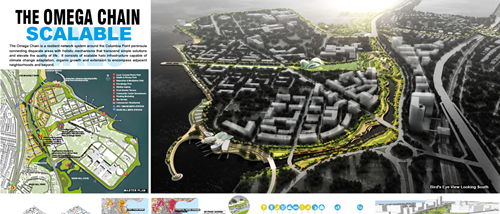
-
“Total Resilient Approach” led by Thetis S.p.A. – This proposal considers the transportation infrastructure as a flexible element aimed at performing a wide range of resilient functions. Raising Morrissey Boulevard and improving its connections to the adjacent neighborhood present an opportunity to redevelop Columbia Point through an overall strategy based on habitat restoration and sustainable urban landscaping.
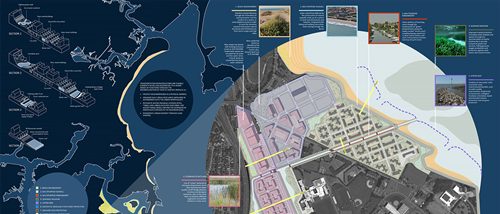
In addition to the jury-selected finalists, Boston Living with Water organizers announced People’s Choice Award winners for each site category, as determined by online voting over the past two weeks. Those distinctions went to “Living Threshold,” led by Fused Studios, Inc., “Open Circuit: Traveling Water,” led by Boston Architectural College, and “Reconnect-Resist-Slow-Collect,” led by HYHW Architects and Planners.
Honorable mentions were also presented to several other competition entrants:
The finalists will continue to develop and refine their proposals before submitting more extensive plans at the end of May. This spring, BSA Space will display a small exhibition of the finalists’ proposals, along with an educational component on sea level rise.
People can follow the latest news about the competition on Twitter @BostonLwW.